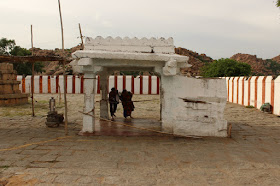August 15, 2018
After a two day-three night stay at Anegundi, we headed towards Dharwad. We left Anegundi early with a plan to visit Kukanoor and Itagi on the way. After Koppal, at Banapur, we took the right fork which goes to Yelburga via Kukanoor. The road was in good condition and barely any traffic, soon we were parking near Mahamaya Devasthana gateway. Navalingeshwara Devasthana, the temple of nine Jyotirlinga -is right besides Mahamaya temple. The entire temple complex was built during Chalukyan rule from VIII to XIII centuries CE.
The temple has at least eleven Garbhagudi if not more, nine Garbhagudi are dedicated to nine Jyotirlinga and one each to Kalleshwara and Mallikarjuna. Standing at the temple entrance, we are looking at two of the Shikharas. The temple architecture is Chalukyan, the stepped Shikhara which can be seen at Pattadakal.
The temple is poorly maintained, to be precise vandalized. Some ignorant people have smeared white paint.. who knows what fun they got by that act. On the other hand, well wishers have coated the temple interior with lime which actually damages the stone. Hope someone takes the initiative to wash it off.
Before we tour the temple, lets take a look at the list of Jyothirlinga-
- Rameshwara at Rameshwaram, Tamil Nadu
- Mallikarjuna at Srisailam, Andhra Pradesh
- Bhimashankar at Pune, Maharashtra
- Tryambakeshwar at Nashik, Maharashtra
- Aundha Nagnath at Hingoli, Maharashtra
- Ghrishneshwar at Verul, Maharashtra
- Somnath in Gujarat
- Mahakaleswar at Ujjain, Madhya Pradesh
- Omkareshwar in Madhya Pradesh
- Baidyanath in Jharkhand
- Kashi Vishwanath at Varanasi, Uttar Pradesh
Of the twelve, nine Jyotirlinga can be seen at this temple complex. Lets start the tour of the temple. We started with Shri Ghushmeshwar, believed as the last or the twelfth Jyotirlinga. The original deity is near Ellora in Maharashtra. It is also called as Grishneshwar.
This is Rameshwar Jyotirlinga at Rameshwaram is the southern most of the twelve Jyotirlinga.
Next is Bhimashankar of Pune. These three Jyotirlinga are positioned around the central Linga whose name I cannot recall.
A damaged Nandi inside a Mantapa. The beautiful pillars have become an eyesore with the lime coating. Behind the Nandi is a doorway which connects to another part of the temple.
Here we have Tryambakeshwar of Nashik. Looks like a sculpted screen stood here originally. I'm guessing based on the elaborately sculpted arch seen here.
The Garbhagudi of Kashi Vishwanatha Jyotirlinga is shrouded in darkness. As seen daily rituals does not happen here, else the Garbhagudi would have been lit up by an oil lamp.
The next two Garbhagudi are also dark and no names painted, I do not know which Jyotirlinga these are.
This is Kedarnatha Jyotirlinga. It seems pooja is performed on weekly basis.
So we have seen eight Jyotirlinga shrines. Not sure if I missed the ninth shrine. Probably the Shivalinga seen in the first few pictures could be a Jyotirlinga.
Here we have a Nandi mounted on a pedestal. This design is commonly seen in Chalukyan temples. Behind Nandi is an inscription.
This inscription is in Kannada, seems like temple records from Chalukyan times.
There are two more inscriptions.
Close to the inscriptions are two more shrines dedicated to Mahakala and Markandeshwara.
A well preserved Nandi decorated with a chain of bells.
This is the present day entrance of the temple. The structure had been restored recently. On the right side is the outer wall built of sandstone. Most Chalukyan temples of VIII cntury are built of this stone.
Damaged sculptures.. Ganesha seems to have bent to right to escape the blow which damaged the arch around him. Slightly lower, on the right is a rectangle with diagonal lines within. I can't remember seeing such mural anywhere else.
Aagh.. pretty sure this is handiwork of some young people. Wondering what instigated them. Well, I'm trying to ignore the damage and admire the beautiful little window. Chalukyan temple builders loved to experiment window designs. One should visit Aihole and Pattadakal to see the experimental models.
Thanks to Chalukyan kings for creating this Jyotirlings center but present day people have neglected it. Wishing government takes interest in restoring and protecting such historic monuments.
From here we move on to Itagi to see the marvelous Mahadeva temple.
.........

















































